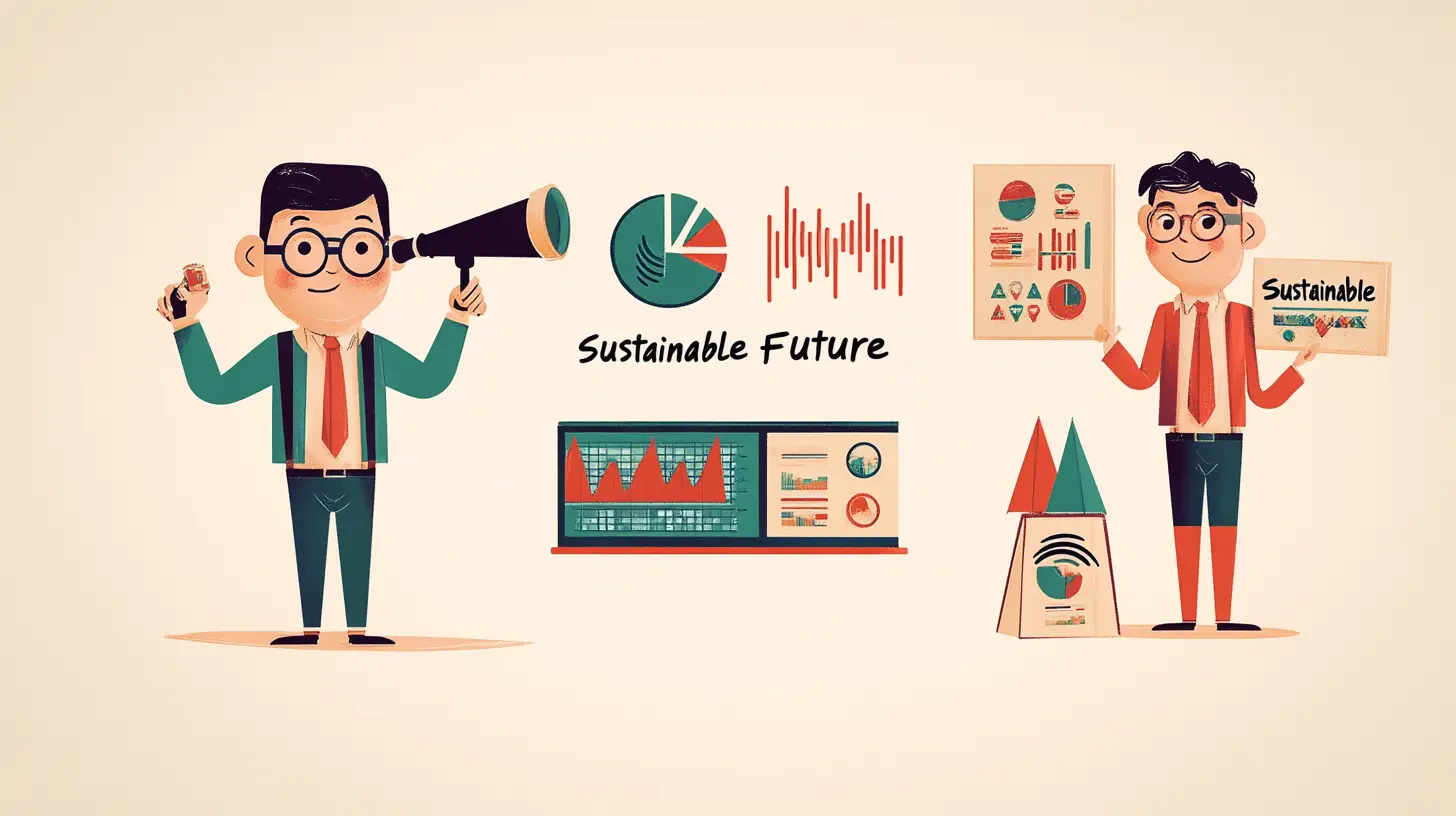What is Renewable Energy? Get to Know Alternative Energy for a Greener World

Renewable energy refers to clean energy derived from natural sources that can be replenished, such as sunlight, wind, water, and biomass. It is sustainable and has a low environmental impact, making it a key alternative to reduce dependence on fossil fuels, support sustainable development, and ensure long-term energy security.
What is Renewable Energy
Renewable energy refers to sources of power that possess distinct characteristics, setting them apart from fossil fuels. The key definitions and features of renewable energy include the following:
- Continuous Generation: Renewable energy is produced repeatedly and never runs out. It originates from natural sources that can replenish themselves, such as sunlight, wind, water, and biomass.
- Sustainability: Unlike fossil fuels, which are finite and depletable, renewable energy sources can be used indefinitely without running out.
- Low Environmental Impact: Renewable energy has minimal effects on the environment. It generates little to no pollution and emits significantly fewer greenhouse gases compared to fossil fuels.
- Diverse Sources: Renewable energy can be derived from a variety of sources, including solar power, wind, water, geothermal heat, biomass, biogas, and agricultural waste.
- Reliance on Local Resources: Renewable energy can be produced from local resources, reducing dependence on imported energy.
- Alignment with Sustainable Development Goals: The use of renewable energy aligns with the United Nations’ Sustainable Development Goals, particularly those related to clean energy and addressing climate change.
In contrast, fossil fuel-based energy—such as oil, natural gas, and coal—is finite and non-renewable. Its use contributes heavily to pollution, especially through the emission of greenhouse gases that significantly impact the global climate.
The transition from fossil fuels to renewable energy is therefore a crucial step in tackling environmental crises and building a more sustainable future for our planet.
Types of Renewable Energy
Renewable energy comes in various forms, each with distinct characteristics and applications. These include:
- Solar Energy: Solar energy is a clean source of power derived from the sun’s radiation. It can be used to generate electricity through solar panels or provide direct heat. Solar cell technology can be installed at both household and utility scales. As an abundant and inexhaustible resource, it holds great potential for sustainable energy production.
- Wind Energy: Wind energy results from variations in temperature and atmospheric pressure. It is harnessed using wind turbines, which convert the kinetic energy of moving air into electricity. Wind energy is a clean power source that effectively reduces greenhouse gas emissions.
- Hydropower: Hydropower is a highly stable energy source that uses the potential energy of water stored in dams or reservoirs. This energy is converted into kinetic energy and then into electricity via turbines and generators. Additionally, tidal and wave energy can also be used to produce electricity.
- Biomass Energy: Biomass energy is generated from organic materials such as agricultural residues, organic waste, or animal manure. These materials are processed through methods such as fermentation, combustion, or gasification to produce heat or electricity. Biomass offers a renewable alternative for managing waste and generating power.
- Geothermal Energy: Geothermal energy is derived from the Earth’s internal heat. It can be used to generate electricity or provide direct heating, particularly in areas with underground hot water or steam sources.
The use of these renewable energy sources helps reduce reliance on fossil fuels, lowers greenhouse gas emissions, and supports sustainable development. However, each type has its own limitations and challenges in terms of development and implementation. A diversified approach that combines multiple forms of renewable energy is considered the most effective path toward long-term energy security and environmental preservation.
Benefits and Importance
Renewable energy plays a vital role in sustainable development, delivering positive impacts across multiple areas.
1. Environmental Impact
- Reducing Greenhouse Gas Emissions: Renewable energy helps reduce the release of carbon dioxide and other greenhouse gases that cause global warming. By replacing fossil fuels with renewable sources, it is possible to mitigate climate-related impacts such as severe storms, flooding, and droughts.
- Minimizing Pollution and Natural Resource Use: Unlike the burning of fossil fuels, renewable energy does not generate air or water pollution. It also helps conserve limited natural resources such as oil and natural gas.
2. Economic Benefits
- Job Creation and Innovation Promotion: The renewable energy sector creates new employment opportunities in manufacturing, installation, and maintenance of clean energy systems. It also drives research and development of more efficient technologies.
- Investment and Business Development Opportunities: The growth of the renewable energy market creates opportunities for investment in emerging businesses such as solar panel production, wind turbine manufacturing, and energy storage systems. This stimulates the economy and generates income for local communities.
3. Energy Security
- Reducing Dependence on Energy Imports: Domestic renewable energy production helps reduce reliance on imported fossil fuels, saving foreign currency and minimizing risks from global energy price volatility.
- Diversifying Energy Sources: Utilizing a variety of renewable energy sources increases flexibility and stability within the energy system. This reduces the risks associated with dependence on a single energy source and helps ensure a more resilient power grid.
Additionally, renewable energy enhances quality of life, especially in remote areas with limited access to electricity. Community-level use of solar or wind energy can provide more widespread and sustainable access to power.
Promoting the use of renewable energy is thus a key strategy for addressing environmental challenges, driving economic development, and ensuring long-term energy security. This approach aligns with the United Nations' Sustainable Development Goals.
Challenges and Limitations
While renewable energy offers numerous benefits, there remain significant challenges and limitations that must be addressed.
1. Cost & Technology
The initial investment cost for installing renewable energy systems remains relatively high, especially for newer technologies. Although prices have been steadily decreasing, cost is still a major barrier to widespread adoption. In addition, some technologies require further development to improve efficiency and economic viability.
2. Location & Resource Constraints
Certain types of renewable energy face geographic limitations. For example, wind energy requires consistently strong wind, typically found only in coastal or high-altitude areas. Solar energy depends on the intensity of sunlight, which fluctuates, resulting in inconsistent energy production. The unpredictability of these natural resources affects the stability of electricity generation.
3. Grid & Storage Issues
Electricity generation from renewable sources is often highly variable, posing challenges for grid management. Developing efficient and low-cost energy storage systems remains a key challenge. Moreover, upgrading electricity infrastructure to accommodate decentralized renewable energy production requires significant investment.
4. Policy & Incentives
The lack of clear and consistent policies and incentives is a major obstacle to the development of renewable energy. In Thailand, although policies exist to promote renewable electricity generation, there are still limitations in procurement volume and pricing mechanisms. A lack of understanding of technology, insufficient support for technological adoption, and a shortage of skilled digital professionals further hinder investment in renewable energy technologies.
There are also emerging concerns about waste management from renewable technologies, such as expired solar panels, which must be properly handled to prevent environmental harm.
Addressing these challenges requires collaboration among all sectors—government, private enterprise, and the public—to develop appropriate policies, technologies, and infrastructure. This will help ensure that renewable energy delivers its full potential in a sustainable and long-term manner.Policies and Supportive Measures
Policies and measures to promote renewable energy play a crucial role in driving the transition toward a clean energy system, both globally and nationally.
1. Global Policies
The United Nations (UN) has established the Sustainable Development Goals (SDGs), with Goal 7 aiming to ensure universal access to affordable, reliable, and sustainable modern energy by 2030. This includes increasing the share of renewable energy in the global energy mix.
The International Energy Agency (IEA) plays a significant role in recommending policies and approaches for the development of renewable energy. It has proposed seven key principles to guide the implementation of net-zero commitments, including support for clean energy investments, innovation development, and the creation of energy systems that are sustainable, secure, and resilient.
2. National Policies
In Thailand, the Power Development Plan (PDP) serves as the country’s key long-term roadmap for electricity production over a 15- to 20-year horizon. It considers energy security, as well as economic, social, and environmental factors. The most recent PDP has increased the share of electricity generation from renewable sources, reflecting the national commitment to promoting clean energy.
Key incentive measures for promoting renewable energy in Thailand include:
- Net Metering: This system offsets the electricity generated from renewable sources against the electricity consumed from the grid, allowing small-scale producers to reduce their electricity bills. However, Thailand currently uses the Net Billing system, which purchases excess electricity at a price lower than the retail rate.
- Tax Incentives: These include exemptions from corporate income tax for renewable electricity generation businesses and import duty exemptions for machinery used in renewable energy production.
In addition, new policies and measures are being developed to keep pace with technological advancements and energy market trends, such as promoting Solar PV Rooftop installations under the Net Billing model, which increases returns for surplus electricity generated.
Nevertheless, challenges remain in the development of policies and measures to support renewable energy. These include determining appropriate purchase volumes and pricing, enhancing grid infrastructure to support decentralized generation, and fostering public understanding and acceptance. Addressing these challenges requires cooperation across all sectors and continuous policy improvement to align with evolving technologies and the country’s energy landscape.
Trends and Innovations
Trends and innovations in renewable energy are advancing rapidly, with a strong focus on increasing efficiency, reducing costs, and overcoming various limitations. Key developments include:
1. New Technologies in Renewable Power Generation
- Advanced Solar Panels: Perovskite solar cells are emerging as a promising technology, offering energy conversion efficiencies of up to 20% while costing less to produce than traditional photovoltaic cells.
- Bladeless Wind Turbines: Aeromine Technologies has developed compact wind turbines that use aerodynamic fins instead of blades. These turbines can generate up to 50% more energy compared to other alternative energy sources, at equal or lower costs.
- Hybrid Solar-Wind Power Systems: French startup Unéole has created a system that combines solar panels with small wind turbines. Designed for installation on buildings, the hybrid system can increase electricity production by up to 40% compared to standard solar panels.
2. Energy Storage and Smart Grid Technologies
- Distributed Energy Storage Systems (DESS): These systems enhance the flexibility and stability of renewable energy generation by storing surplus electricity and supplying it during times of insufficient production.
- Smart Grid Technology: By incorporating sensors and two-way communication systems, smart grids enable intelligent control over energy production, distribution, and consumption for greater efficiency.
- AI and Big Data Applications: These tools are used for forecasting electricity production and demand, as well as enabling predictive maintenance to optimize the performance of renewable energy systems.
3. Research and Development in Materials and Equipment Design
- Nanomaterials for Solar Panels: The use of nanomaterials improves light absorption and energy conversion efficiency, resulting in thinner and more effective solar panels.
- Wind Turbine Blade Design: Research is ongoing to improve blade design for better performance, enhanced durability in harsh weather conditions, and reduced noise pollution.
In addition, green hydrogen technology is being developed as an energy storage medium that can store power from renewable sources and support efficient electricity usage.
These trends highlight the ongoing evolution within the renewable energy industry, aiming to build cleaner, more efficient, and more sustainable energy systems. However, widespread adoption of these technologies still requires strong policy support, investment, and the development of suitable infrastructure.
Summary and Recommendations
Renewable energy is a crucial alternative in addressing global energy and environmental challenges. It offers numerous benefits, including reducing greenhouse gas emissions, enhancing energy security, and stimulating the economy through job creation and new innovations. However, transitioning to a renewable energy-dominated system presents several challenges.
In the context of Thailand, renewable energy development has made steady progress. Nevertheless, further policy support and refinement are needed to achieve long-term goals of emission reduction and energy security.
Recommendations for Advancing Renewable Energy in Thailand:
- Develop infrastructure: Accelerate the development of smart grid systems and energy storage solutions to accommodate the variability of renewable energy sources and improve energy management efficiency.
- Promote research and development: Support R&D in renewable energy technologies and energy storage systems to reduce costs and improve efficiency—especially technologies suited to Thailand’s context, such as dry biogas production systems for local communities.
- Foster collaboration among government, private sector, and communities: Encourage participation from all sectors in renewable energy initiatives, particularly at the community level. Programs like Energy for All empower communities to generate and sell electricity from renewable sources.
- Invest in human capital and public awareness: Strengthen workforce skills in the renewable energy sector and raise public awareness about the benefits and importance of clean energy.
- Encourage renewable energy adoption in the business sector: Provide tax incentives and technical support to promote 100% clean energy use, especially among large-scale industries, to enhance their competitiveness in a global market increasingly focused on sustainability.
- Develop waste management strategies for renewable energy equipment: Plan and establish systems to manage electronic waste from decommissioned renewable energy equipment—such as solar panels and batteries—to mitigate long-term environmental impact.
Implementing these recommendations will accelerate the transition toward a cleaner and more sustainable energy system. This shift will not only help address environmental issues but also unlock economic opportunities and improve the quality of life for citizens in the long run. Achieving this vision requires concerted efforts from the government, private sector, and the public to transform energy consumption behaviors and support the development of clean energy technologies—for a sustainable future for Thailand and the world.
Notable Documents or Research
The study of renewable energy in Thailand has been continuously evolving, with several noteworthy documents and articles available, including the following:
- The report titled "Promotion of Alternative Energy, Renewable Energy, and Substitutable Energy" by Atchara Chinniyompanit presents an overview of Thailand’s policies and measures to promote renewable energy, along with an analysis of the challenges and obstacles in its development.
- The study "Factors Influencing the Adoption of Solar Energy through Solar Cells in Residential Areas of Bangkok and Surrounding Provinces" by Saisunee Sitthimongkol analyzes the key factors affecting the decision to install solar cell systems in households. The findings serve as important data for planning the promotion of solar energy use in the residential sector.
- The research article "Assessment of Renewable Energy Potential for Power Development Planning in Southern Thailand" by Suwit Phetchhuailuek and colleagues presents an analysis of renewable energy sources in the southern region of the country. This serves as vital information for regional energy planning.
- The book "Renewable Energy" by Associate Professor Dr. Kraiphat Cheenkajorn offers fundamental knowledge on various types of renewable energy, as well as related technologies and applications. It is well-suited for those seeking to understand renewable energy from a broader perspective.
- The study "Renewable Energy Demand through Renewable Energy Certificates" by Sirawit Bunsoemsuk analyzes trends and demand for Renewable Energy Certificates (RECs) in Thailand. These certificates are a key mechanism for promoting clean energy usage in the business sector.
These documents and articles provide diverse insights into renewable energy in Thailand—from policy and technology to potential and consumer behavior. They are especially valuable for individuals interested in studying or developing renewable energy within the Thai context. Studying these materials offers a deeper understanding of the current landscape, challenges, and opportunities for renewable energy development in Thailand.
About Optiwise
Optiwise offers Investor Relations & ESG consulting services, corporate website design, and IR website development. We also provide advisory services for initial public offerings (IPOs) and assists in preparing disclosure documents for public companies. Additionally, our public relations efforts aim to build credibility and enhance the corporate image.
For more information about Optiwise's services, please contact us here.


